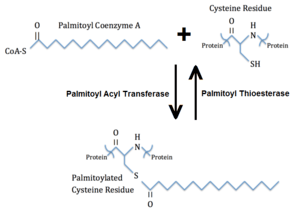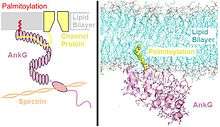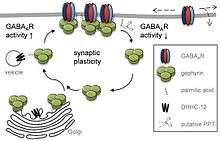Palmitoylation


Palmitoylation is the covalent attachment of fatty acids, such as palmitic acid, to cysteine and less frequently to serine and threonine residues of proteins, which are typically membrane proteins.[2] The precise function of palmitoylation depends on the particular protein being considered. Palmitoylation enhances the hydrophobicity of proteins and contributes to their membrane association. Palmitoylation also appears to play a significant role in subcellular trafficking of proteins between membrane compartments,[3] as well as in modulating protein–protein interactions.[4] In contrast to prenylation and myristoylation, palmitoylation is usually reversible (because the bond between palmitic acid and protein is often a thioester bond). The reverse reaction in mammalian cells is catalyzed by acyl-protein thioesterases (APTs) in the cytosol and palmitoyl protein thioesterases in lysosomes. Because palmitoylation is a dynamic, post-translational process, it is believed to be employed by the cell to alter the subcellular localization, protein–protein interactions, or binding capacities of a protein.
An example of a protein that undergoes palmitoylation is hemagglutinin, a membrane glycoprotein used by influenza to attach to host cell receptors.[5] The palmitoylation cycles of a wide array of enzymes have been characterized in the past few years, including H-Ras, Gsα, the β2-adrenergic receptor, and endothelial nitric oxide synthase (eNOS). Another example is the major signaling protein Wnt, which is modified by a palmitoleoyl group at a serine. This is a type of O-acylation and is mediated by a membrane-bound O-acyltransferase.[6] In signal transduction via G protein, palmitoylation of the α subunit, prenylation of the γ subunit, and myristoylation is involved in tethering the G protein to the inner surface of the plasma membrane so that the G protein can interact with its receptor.[7]
The palmitoylome
A meta-analysis of 15 studies produced a compendium of approximately 2,000 mammalian proteins that are palmitoylated. The highest associations of the palmitoylome are with cancers and disorders of the nervous system. Approximately 40% of synaptic proteins were found in the palmitoylome.[8]
In synaptic plasticity
Scientists have appreciated the significance of attaching long hydrophobic chains to specific proteins in cell signaling pathways. A good example of its significance is in the clustering of proteins in the synapse. A major mediator of protein clustering in the synapse is the postsynaptic density (95kD) protein PSD-95. When this protein is palmitoylated it is restricted to the membrane. This restriction to the membrane allows it to bind to and cluster ion channels in the postsynaptic membrane. Also, in the presynaptic neuron, palmitoylation of SNAP-25 directs it to partition in the cell membrane [9] and allows the SNARE complex to dissociate during vesicle fusion. This provides a role for palmitoylation in regulating neurotransmitter release.[10]
Palmitoylation of delta catenin seems to coordinate activity-dependent changes in synaptic adhesion molecules, synapse structure, and receptor localizations that are involved in memory formation.[11]
Palmitoylation of gephyrin has been reported to influence GABAergic synapses.[1]
See also
References
- 1 2 Dejanovic B, Semtner M, Ebert S, Lamkemeyer T, Neuser F, Lüscher B, Meier JC, Schwarz G (July 2014). "Palmitoylation of gephyrin controls receptor clustering and plasticity of GABAergic synapses". PLOS Biology. 12 (7): e1001908. doi:10.1371/journal.pbio.1001908. PMC 4099074. PMID 25025157.
- ↑ Linder, M.E., "Reversible modification of proteins with thioester-linked fatty acids," Protein Lipidation, F. Tamanoi and D.S. Sigman, eds., pp. 215-40 (San Diego, CA: Academic Press, 2000).
- ↑ Rocks O, Peyker A, Kahms M, Verveer PJ, Koerner C, Lumbierres M, Kuhlmann J, Waldmann H, Wittinghofer A, Bastiaens PI (2005). "An acylation cycle regulates localization and activity of palmitoylated Ras isoforms". Science. 307 (5716): 1746–1752. doi:10.1126/science.1105654. PMID 15705808.
- ↑ Basu, J., "Protein palmitoylation and dynamic modulation of protein function," Current Science, Vol. 87, No. 2, pp. 212-17 (25 July 2004), http://www.ias.ac.in/currsci/jul252004/contents.htm
- ↑ "INFLUENZA VIRUSES (ORTHOMYXOVIRIDAE)". Encyclopedia of Virology: 830–836. doi:10.1006/rwvi.1999.0157.
- ↑ Takada R, Satomi Y, Kurata T, Ueno N, Norioka S, Kondoh H, Takao T, Takada S (2006). "Monounsaturated fatty acid modification of Wnt protein: its role in Wnt secretion". Dev Cell. 11 (6): 791–801. doi:10.1016/j.devcel.2006.10.003. PMID 17141155.
- ↑ Wall, MA; Coleman, DE; Lee, E; Iñiguez-Lluhi, JA; Posner, BA; Gilman, AG; Sprang, SR (Dec 15, 1995). "The structure of the G protein heterotrimer Gi alpha 1 beta 1 gamma 2". Cell. 83 (6): 1047–58. doi:10.1016/0092-8674(95)90220-1. PMID 8521505.
- ↑ Sanders SS, Martin DD, Butland SL, Lavallée-Adam M, Calzolari D, Kay C, Yates JR, Hayden MR (August 2015). "Curation of the Mammalian Palmitoylome Indicates a Pivotal Role for Palmitoylation in Diseases and Disorders of the Nervous System and Cancers". PLoS Computational Biology. 11 (8): e1004405. doi:10.1371/journal.pcbi.1004405. PMC 4537140. PMID 26275289.
- ↑ Greaves, Jennifer (March 2011). "Differential palmitoylation regulates intracellular patterning of SNAP25". Journal of Cell Science. 124 (8): 1351–1360. doi:10.1242/jcs.079095. PMC 3065388. PMID 21429935.
- ↑ "Molecular Mechanisms of Synaptogenesis." Edited by Alexander Dityatev and Alaa El-Husseini. Springer: New York, NY. 2006. pg. 72-75
- ↑ Brigidi GS, Sun Y, Beccano-Kelly D, Pitman K, Jobasser M, Borgland SL, Milnerwood AJ, Bamji SX (January 23, 2014). "Palmitoylation of [delta]-catenin by DHHC5 mediates activity-induced synapse plasticity". Nature Neuroscience. 17: 522–532. doi:10.1038/nn.3657. PMC 5025286.
Further reading
- Smotrys J, Linder A (2004). "Palmitoylation of Intracellular Signaling Proteins: Regulation and Function". Annu Rev Biochem. 73: 559–87. doi:10.1146/annurev.biochem.73.011303.073954. PMID 15189153.
- Resh, M. (2006) "Palmitoylation of Ligands, Receptors, and Intracellular Signaling Molecules". Sci STK. 359 October 31.
- Linder M, Deschenes R (2007). "Palmitoylation: policing protein stability and traffic". Nature Reviews Molecular Cell Biology. 8: 74–84. doi:10.1038/nrm2084. PMID 17183362.
